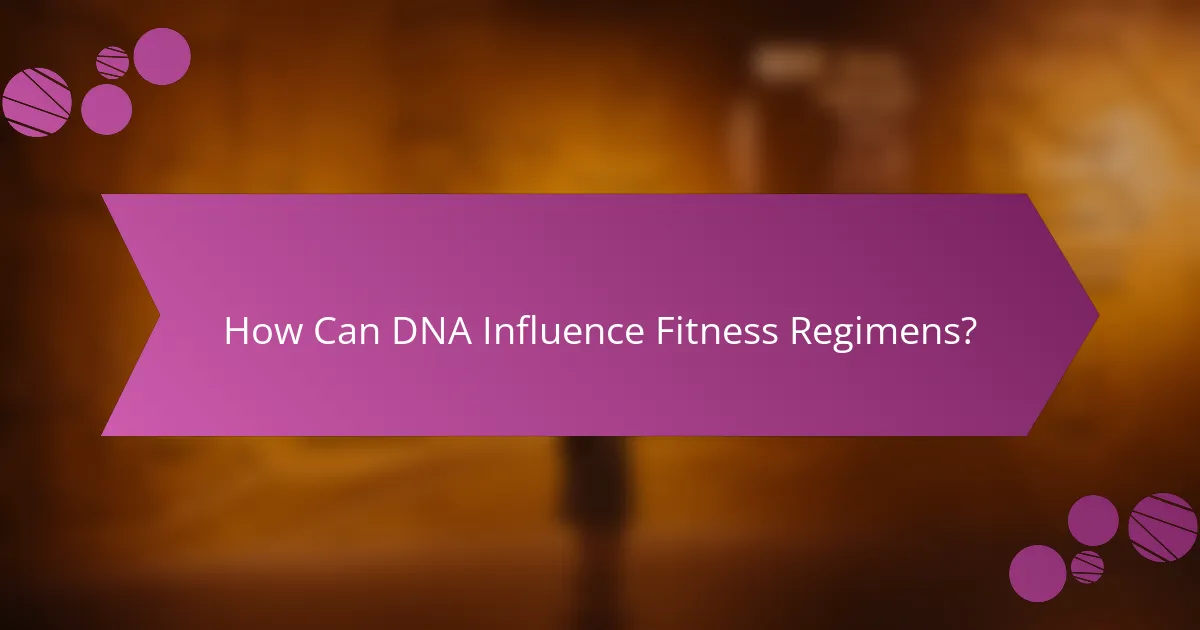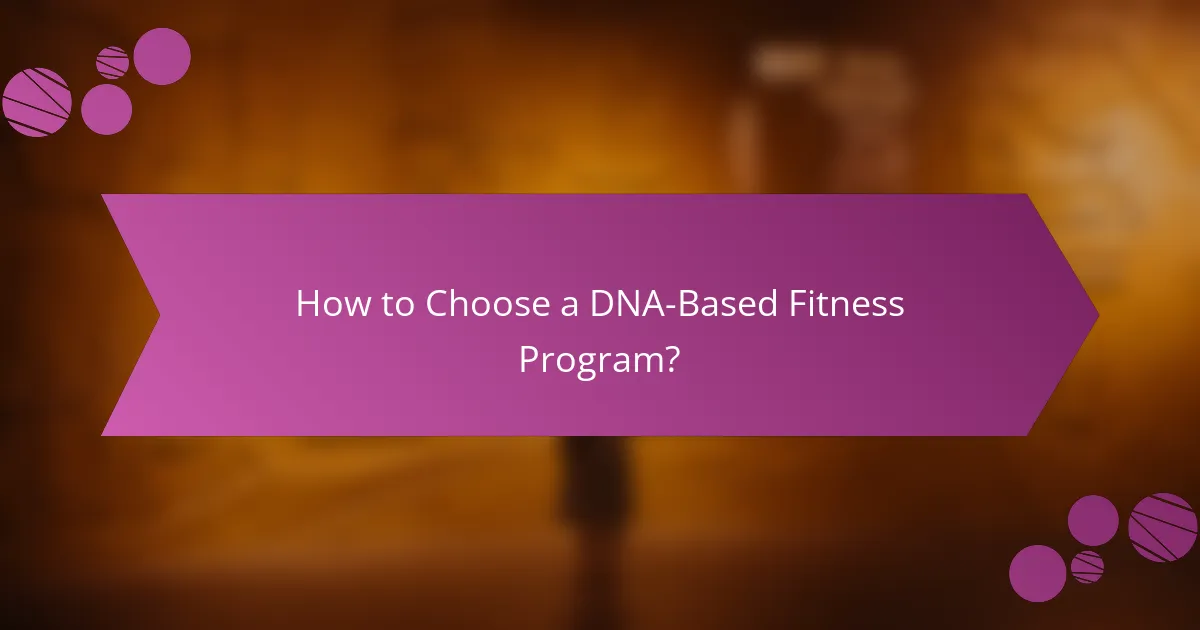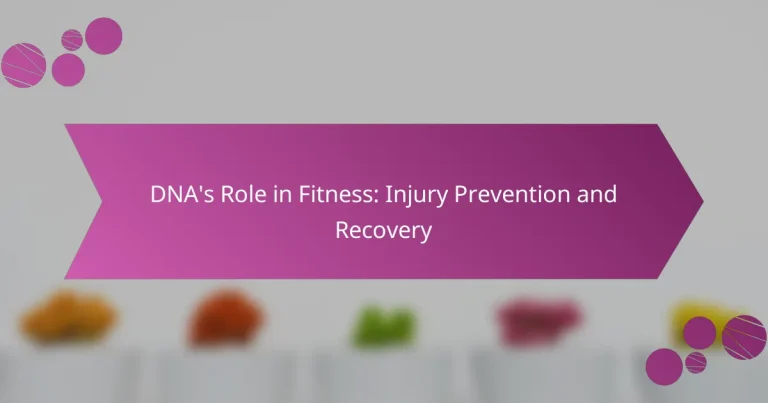DNA-Based Fitness Regimens: Science, Benefits and Beginner Tips
DNA-based fitness regimens leverage genetic insights to create personalized exercise and nutrition plans, optimizing performance and recovery. By understanding how genetic traits influence physical capabilities, individuals can tailor their fitness strategies for better results and injury prevention. This approach not only enhances workout effectiveness but also promotes overall well-being.

How Can DNA Influence Fitness Regimens?
DNA can significantly influence fitness regimens by identifying genetic traits that affect physical performance, recovery, and nutrition. Understanding these genetic factors allows individuals to tailor their exercise and dietary plans for optimal results.
Genetic predispositions
Genetic predispositions refer to inherited traits that can impact an individual’s fitness capabilities. For example, some people may have a genetic advantage in endurance activities, while others may excel in strength-based exercises. Knowing these predispositions can help in selecting the most effective workout types.
To assess genetic predispositions, DNA testing services can analyze specific markers associated with athletic performance. This information can guide individuals in focusing on workouts that align with their natural strengths, potentially leading to better outcomes and reduced injury risk.
Personalized workout plans
Personalized workout plans are designed based on genetic insights to maximize fitness results. By understanding how one’s body responds to different types of exercise, individuals can create routines that enhance performance and recovery. For instance, someone with a genetic inclination towards fast-twitch muscle fibers may benefit more from high-intensity interval training.
When developing a personalized plan, consider factors such as recovery times and injury susceptibility, which can also be influenced by genetics. This tailored approach can lead to more efficient training sessions and improved overall fitness levels.
Nutrition optimization
Nutrition optimization involves adjusting dietary choices based on genetic information to support fitness goals. Certain genetic markers can indicate how well an individual metabolizes carbohydrates, fats, or proteins, influencing dietary recommendations. For example, someone who processes carbohydrates efficiently may thrive on a higher-carb diet.
To optimize nutrition, individuals can use DNA analysis to identify food sensitivities or nutrient needs. This can help in creating meal plans that enhance energy levels and recovery, ultimately supporting fitness regimens more effectively. Regularly reviewing and adjusting dietary habits based on ongoing fitness progress is also advisable.

What Are the Benefits of DNA-Based Fitness?
DNA-based fitness regimens offer personalized approaches to exercise and nutrition, leading to improved outcomes. By analyzing genetic markers, individuals can tailor their fitness plans to enhance performance, prevent injuries, and promote faster recovery.
Improved performance
DNA-based fitness can significantly enhance athletic performance by aligning training programs with an individual’s genetic predispositions. For example, some people may have genes that favor endurance, while others excel in strength-based activities. Understanding these traits allows for more effective training strategies.
To maximize performance, consider integrating specific exercises that align with your genetic strengths. For instance, if your DNA suggests a propensity for power, focus on high-intensity interval training (HIIT) or weightlifting to leverage your natural abilities.
Injury prevention
Injury prevention is a critical benefit of DNA-based fitness, as genetic insights can reveal predispositions to certain injuries. By understanding these risks, individuals can modify their training regimens to avoid common pitfalls associated with their genetic makeup.
For example, if your genetic analysis indicates a higher likelihood of joint issues, incorporating low-impact exercises like swimming or cycling can reduce strain. Additionally, proper warm-up and cool-down routines tailored to your genetic profile can further mitigate injury risks.
Enhanced recovery
DNA-based fitness can lead to enhanced recovery by identifying optimal recovery strategies based on genetic factors. Certain genes influence how quickly muscles repair and how effectively the body manages inflammation, which are crucial for recovery after workouts.
To improve recovery, consider adjusting your post-workout nutrition and rest periods according to your genetic insights. For instance, if your DNA suggests slower recovery rates, prioritize protein intake and longer rest intervals to support muscle healing and overall performance.

What Are the Best DNA Testing Services for Fitness?
The best DNA testing services for fitness provide insights into how your genetic makeup influences your health, exercise response, and nutrition needs. These services can help tailor fitness regimens to your unique genetic profile, enhancing your workout effectiveness and overall well-being.
23andMe
23andMe offers a comprehensive DNA testing service that includes health, ancestry, and fitness reports. Their fitness-related insights focus on how your genes may affect your muscle composition, recovery, and exercise performance.
When using 23andMe, you can expect to receive information on your genetic predispositions to certain fitness traits, which can guide your training approach. The service is user-friendly, with online access to your results and recommendations based on your genetic data.
DNAfit
DNAfit specializes in fitness and nutrition insights derived from your DNA. This service analyzes your genetic markers to provide personalized recommendations for exercise types, intensity levels, and dietary adjustments.
With DNAfit, you receive a detailed report that outlines optimal workout strategies and nutritional plans tailored to your genetic profile. This can help you maximize your fitness results and avoid common pitfalls associated with generic fitness advice.
MyHeritage
MyHeritage primarily focuses on ancestry but also offers DNA testing that includes health and wellness insights. Their fitness-related features are less comprehensive than those of dedicated fitness services but can still provide valuable information on your genetic predispositions.
While MyHeritage may not offer as many tailored fitness recommendations, it can still serve as a supplementary tool for understanding your overall health. Consider combining it with a more fitness-focused service for a well-rounded approach to your DNA-based fitness regimen.

How to Choose a DNA-Based Fitness Program?
Choosing a DNA-based fitness program involves understanding your personal fitness goals, leveraging genetic insights, and evaluating the credibility of the program. This approach ensures that the regimen aligns with your unique biological makeup and lifestyle preferences.
Assess personal goals
Start by clearly defining your fitness objectives. Are you aiming to lose weight, build muscle, improve endurance, or enhance overall health? Having specific goals helps in selecting a program that caters to your needs.
Consider using the SMART criteria for goal setting: make your goals Specific, Measurable, Achievable, Relevant, and Time-bound. For example, instead of saying “I want to get fit,” aim for “I want to run a 5K in under 30 minutes within three months.” This clarity will guide your DNA-based program choice.
Consider genetic insights
Genetic testing can provide valuable insights into how your body responds to different types of exercise and nutrition. Look for programs that incorporate these insights to tailor workouts and dietary recommendations based on your DNA.
For instance, some individuals may have a genetic predisposition for endurance activities, while others may excel in strength training. Understanding these traits can help you choose a program that maximizes your potential and minimizes the risk of injury.
Evaluate program credibility
Before committing to a DNA-based fitness program, research its credibility. Look for programs backed by scientific research and those that employ certified professionals in genetics and fitness.
Check for reviews and testimonials from other users to gauge effectiveness. Additionally, ensure that the program complies with relevant health regulations and standards, particularly if it involves genetic testing. A reputable program should also provide clear information on how your genetic data will be used and protected.

What Are Beginner Tips for Implementing DNA-Based Fitness?
To effectively implement DNA-based fitness regimens, beginners should focus on understanding their genetic makeup and how it influences their fitness journey. This involves starting with basic testing, making gradual changes to their routine, and regularly monitoring their progress to ensure they are on the right track.
Start with basic testing
Begin by obtaining a DNA test that analyzes your genetic predispositions related to fitness, nutrition, and recovery. Many companies offer kits that can be ordered online, and results typically take a few weeks. Understanding your genetic profile can provide insights into which types of exercise and dietary approaches may work best for you.
Look for tests that cover key areas such as muscle composition, metabolism, and injury risk. This foundational knowledge will help you tailor your fitness regimen to align with your unique genetic traits.
Integrate gradual changes
When implementing changes based on your DNA results, start slowly to avoid overwhelming your body. For example, if your test suggests a higher tolerance for endurance activities, gradually increase your cardio sessions over several weeks. Aim for small, manageable adjustments rather than drastic shifts.
Consider incorporating new exercises or dietary modifications one at a time. This way, you can assess how your body responds and make necessary adjustments without risking injury or burnout.
Monitor progress regularly
Regularly track your fitness progress to evaluate the effectiveness of your DNA-based regimen. Use a journal or fitness app to log workouts, dietary changes, and how you feel physically and mentally. Aim to review your progress every few weeks to identify trends and make informed decisions about future adjustments.
Additionally, consider periodic retesting to see if your genetic insights still hold true as your fitness level evolves. This ongoing assessment will help you stay aligned with your goals and ensure your regimen remains effective over time.


